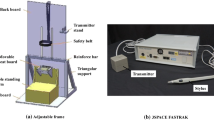Abstract
Objectives
To create age- and gender-specific Triceps Skinfold Thickness percentile curves for Indian children; and to determine cut-offs for predicting the risk of childhood hypertension.
Design
Cross-sectional.
Setting
Multicentric, school-based, 5 major Indian cities
Participants
13375 children (7590 boys) aged 5-17 years
Procedure
Data on height, weight, blood pressure, triceps skinfold thickness (using Harpenden Skinfold caliper) were collected. Reference triceps skinfold thickness percentile curves were derived for boys and girls by LMS (lambda-mu-sigma) method. Receiver operating curve analyses were performed to determine the optimal cut-off of triceps skinfold thickness centile for predicting the risk of hypertension.
Results
Percentile curves for boys plateau around 13 years whereas for girls the curves increase steadily till the age of 17 years. Median triceps skinfold thickness increased by 7% to 9% till the age of 9 years in boys and girls. After 12 years, median triceps skinfold thickness decreased by 1% to 2% in boys but increased by 3% to 4% in girls. The optimal cut-off percentile yielding maximal sensitivity (68%) and specificity (74-78%) for predicting high blood pressure was the 70th triceps skinfold thickness percentile in both genders.
Conclusions
Percentile curves for triceps skinfold thickness developed in the present study would be useful in the assessment of adiposity and the risk of hypertension in Indian children.
Similar content being viewed by others
References
Reilly JJ, Wilson J, Durnin JV. Determination of body composition from skinfold thickness: a validation study. Arch Dis Child. 1995;(73):305–10.
Freedman DS, Dietz WH, Srinivasan SR, Berenson GS. Risk factors and adult body mass index among overweight children: the Bogalusa Heart Study. Pediatrics. 2009;(123):750–7.
Freedman DS, Wang J, Ogden CL, Thornton JC, Mei Z, Pierson RN, et al. The prediction of body fatness by BMI and skinfold thicknesses among children and adolescents. Ann Hum Biol. 2007;(34):183–94.
Himes JH, Dietz WH. Guidelines for overweight in adolescent preventive services: recommendations from an expert committee. The Expert Committee on Clinical Guidelines for Overweight in Adolescent Preventive Services. Am J Clin Nutr. 1994;(59):307–16.
Moser DC, Giuliano Ide C, Titski AC, Gaya AR, Coelhoe-Silva MJ, Leite N. Anthropometric measures and blood pressure in school children. J Pediatr (Rio J). 2013;(89):243–9.
Kajale NA, Khadilkar AV, Chiplonkar SA, Khadilkar VV. Body fat indices for identifying risk of hypertension in Indian children. Indian Pediatr. 2014;(51):555–60.
Jaworski M, Ku3aga Z, P3udowski P, Grajda A, Gurzkowska B, Napieralska E, et al.; OLAF Study Group. Population-based centile curves for triceps, subscapular, and abdominal skinfold thicknesses in Polish children and adolescents–the OLAF study. Eur J Pediatr. 2012;(171):1215–21.
Addo OY, Himes JH. Reference curves for triceps and subscapular skinfold thicknesses in US children and adolescents. Am J Clin Nutr. 2010;(91):635–42.
Khadilkar A, Ekbote V, Chiplonkar S, Khadilkar V, Kajale N, Kulkarni S, et al. Waist circumference percentiles in 2-18 year old Indian children. J Pediatr. 2014;(164):1358–62.
Indian Academy of Pediatrics Growth Charts Committee, Khadilkar V, Yadav S, Agrawal KK, Tamboli S, Banerjee M, Cherian A, et al. Revised IAP growth charts for height, weight and body mass index for 5–to 18-year-old Indian Children. Indian Pediatr.2015.52:47-55.
Khadilkar VV, Khadilkar AV, Borade AB, Chiplonkar SA. Body mass index cut-offs for screening for childhood overweight and obesity in Indian children. Indian Pediatr. 2012;(49):29–34.
Khadilkar VV, Khadilkar AV, Cole TJ, Sayyad MG. Cross-sectional growth curves for height, weight and body mass index for affluent Indian children, 2007. Indian Pediatr. 2009;(46):477–89.
National Health and Nutrition Examination Survey. Anthropometry Procedures Manual (revised January 2004); 35. Available from: http://www.cdc.gov/nchs/data/nhanes/nhanes_03_04/BM.pdf. Accessed October 28, 2014.
National High Blood Pressure Education Program Working Group on High Blood Pressure in Children and Adolescents. The fourth report on the diagnosis, evaluation, and treatment of high blood pressure in children and adolescents. Pediatrics. 2004;(114):555–76.
van ‘t Hof MA, Wit JM, Roede MJ. A method to construct age references for skewed skinfold data, using Box-Cox transformations to normality. Hum Biol. 1985;(57):131–9.
Cole TJ, Green PJ. Smoothing reference centile curves: the LMS method and penalized likelihood. Stat Med. 1992;(11):1305–19.
van Buuren S, Fredriks M. Worm plot: a simple diagnostic device for modelling growth reference curves. Stat Med. 2001;(20):1259–77.
Cole TJ, Bellizzi MC, Flegal KM, Dietz WH. Establishing a standard definition for child overweight and obesity worldwide: international survey. BMJ. 2000;(320):1240–3.
Krebs NF, Himes JH, Jacobson D, Nicklas TA, Guilday P, Styne D. Assessment of child and adolescent overweight and obesity. Pediatrics. 2007;120:S193–228.
Pandit D, Chiplonkar S, Khadilkar A, Khadilkar V, Ekbote V. Body fat percentages by dual-energy X-ray absorptiometry corresponding to body mass index cutoffs for overweight and obesity in Indian Children. Clin Med Pediatr. 2009;(3):55–61.
WHO Expert Consultation. Appropriate body-mass index for Asian populations and its implications for policy and intervention strategies. Lancet. 2004;(363):157–63.
Yajnik CS, Yudkin JS. The Y-Y paradox. Lancet. 2004;(363):163.
Sardinha LB, Going SB, Teixeira PJ, Lohman TG. Receiver operating characteristic analysis of body mass index, triceps skinfold thickness and arm girth for obesity screening in children and adolescents. Am J Clin Nutr. 1999;(70):1090–5.
Author information
Authors and Affiliations
Corresponding author
Rights and permissions
About this article
Cite this article
Khadilkar, A., Mandlik, R., Chiplonkar, S. et al. Reference centile curves for triceps skinfold thickness for Indian children aged 5–17 years and cut-offs for predicting risk of childhood hypertension: A multi-centric study. Indian Pediatr 52, 675–680 (2015). https://doi.org/10.1007/s13312-015-0695-x
Received:
Revised:
Accepted:
Published:
Issue Date:
DOI: https://doi.org/10.1007/s13312-015-0695-x




